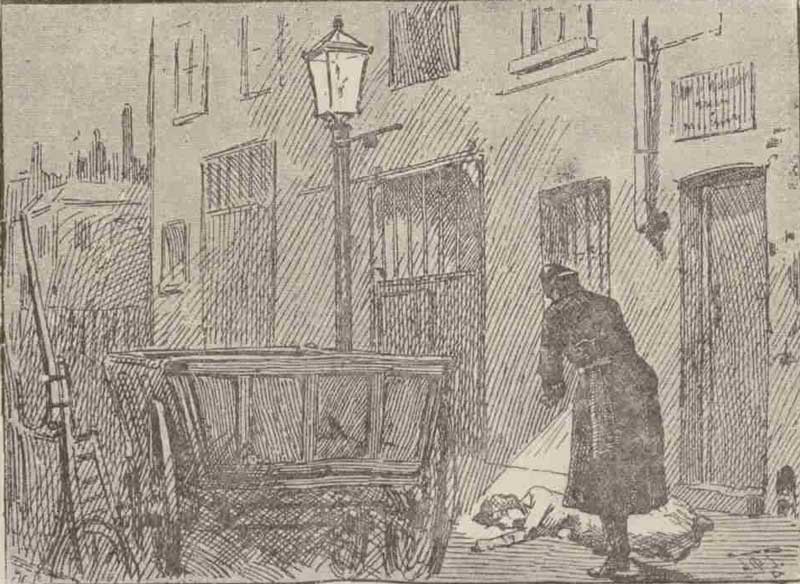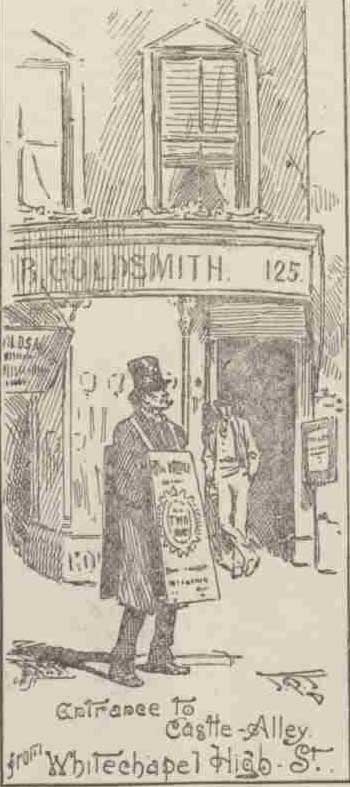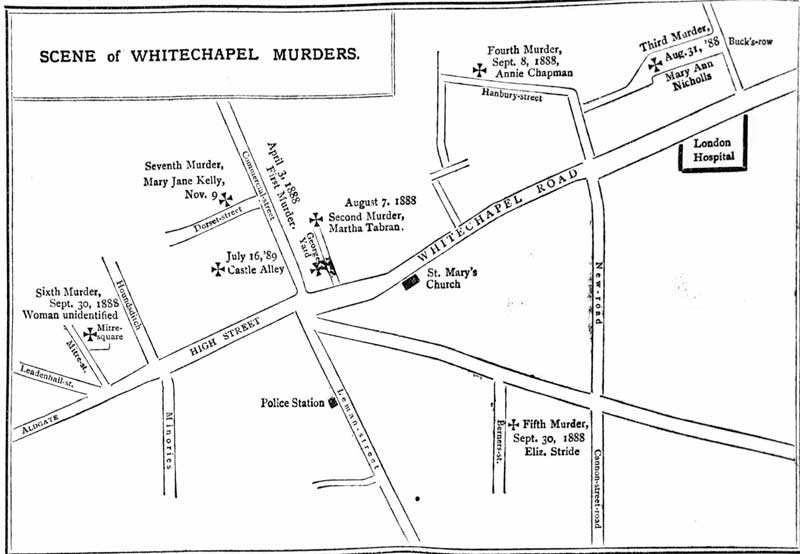On the 17th of July 1889, the people of the East End were waking up to news that, after an absence of many months, it appeared that Jack the Ripper had returned to the streets of the East End, and had carried out another murder.
The victim this time was Alice McKenzie, and. today, she tends not to be numbered amongst the actual victims of Jack the Ripper.
However, at the time, nobody could be certain that this was the case and, in the immediate aftermath of her murder, the newspapers were reporting the crime as having been carried out by the same hand that had carried out the horrible atrocities in the previous autumn of 1888.

“JACK THE RIPPER” AT IT AGAIN
ANOTHER WHITECHAPEL TRAGEDY
A WOMAN MURDERED AND MUTILATED IN SPITALFIELDS
About midnight last night there was committed in the Whitechapel, Spitalfields quarter a murder, attended by mutilation, which bore a most startling resemblance to the atrocities which so shocked and sickened London during the latter part of last year.
Various arrests are reported; but it is clear the murder-fiend has once more escaped detection.
It would appear from various accounts that as the policeman on beat in Wentworth-street, off Commercial-street, was passing up Castle Alley, which leads into High-street, Whitechapel, at about ten minutes to one o’clock this morning, he came upon the murdered and mutilated body of an unfortunate woman, which was lying under a gas lamp in front of Messrs. King and Sons’ warehouse, in Billiter-street.
The body lay against the lamp-post in a pool of blood.
THROAT CUT FROM EAR TO EAR
The a woman, who seemed to be about 40 years of age, had her throat cut from ear to ear, and two deep gashes, evidently inflicted with a sharp instrument, in the lower part of the abdomen.
The murderer evidently had not the time to finish his work, as the body was not so terribly mutilated there as was the case in some of the previous murders.
The police officer found that the body was still warm, and further investigation makes it more and more apparent that the murderer was suddenly disturbed in his operation.
The woman’s clothes were thrown up towards the face, but only the navel was slashed and there was no protrusion of intestines.
The spot chosen for the ghastly deed is at night the most prominent part of the whole alley, and is within a very short distance of High-street, Whitechapcl, and Commercial-street.
The warehouse in front of which the gas lamp stands is a large three-storied building, and in the vicinity are costermongers’ carts and large waggons standing in every direction.

THE BODY EXAMINED AT THE SCENE
The constable immediately whistled for assistance, and a number of policemen quickly arrived on the spot.
The discovery was made known at once at Commercial-street police-station, and Dr. Phillips and Brown were communicated with.
Immediately on their arrival they examined the nature of the wounds, and informed the police that the murder must have been done by the same person or persons who committed the series of previous murders in Whitechapel and Spitalfields.
They ordered the body to be conveyed to Montague-street Mortuary, where it now lies in a box coffin awaiting the inquest.
Beyond the fact that the victim is about forty years of age, of dark complexion, and very shabbily dressed, nothing is known about her, and she has not as yet been identified.
A LARGE CROWD GATHERED
The news that another murder and mutilation had taken place quickly spread in the neighbourhood and by the early morning a large crowd of men and women, chiefly costermongers, and those having business to do in the vegetable market close at hand, assembled round the scene of the murder.
CASTLE ALLEY – THE MURDER SITE
Castle-alley is in the midst of a maze of streets and alleys, which are infested by, perhaps, the worst class of society in London.
It is within a stone’s throw of Dorset-street, Hanbury-street, Flower and Dean-street, and other notorious localities which abound in common lodgings houses, and are infested by unfortunates of the very lowest class in the East-end.
The exits for the escape of a murderer are numerous, as he could easily reach any part of Whitechapel or Spitalfields free from being observed in this poor locality.

A CONSTABLE STATIONED AT THE ENTRANCE
A curious fact is that since the previous murders in the vicinity a constable has been stationed at the Whitechapel entrance of the court, and there is also a watchman on duty at the baths, but neither of them heard any scream or noise of any kind.
After the discovery, Superintendent Arnold, Chief-Inspector West and Inspector Reid were on the spot, and gave directions to the constables for the removal of the body and the pursuit of the culprit.
Mr. Monro, Chief Commissioner of the Metropolitan Police, and Colonel Monsell were aroused from bed, and were in Castle-alley within an hour and a half of the discovery of the body.
The police at once commenced an active search of all the surrounding houses, but up to the present time, as already stated, the murderer remains at large.
INTERVIEW WITH THE FIRST CIVILIAN WHO SAW THE BODY
Isaac Lewis, of Old Castle-street, was the first civilian who saw the body after the murder.
He says he was running home when the police-constable came towards him and asked him “for God’s sake” to go to the woman and stand by while he called assistance.
Lewis obeyed the constable, and went to the spot.
He closely examined the body, while the constable was blowing his whistle
It was that of a middle-aged woman, poorly clad. The clothes were all crushed up on her chest, her body and legs being nude.
Her throat was not cut in front, but was pierced much the same as the throats of sheep are pierced by butchers.
The only wound on the body was a cut below the right breast, which did not extend to the abdomen.
There was a blood mark on the face and left thigh, as if an open blood-covered hand had been placed on them.
The body was warm when he saw it, and the blood was gushing from the throat very fast.
The stockings were odd ones, and the boots dilapidated.
Lewis has made the following remarkable statement:- He says that a man named Burrows owns the greater number of barrows standing in the alley. Up to about two weeks ago he employed a night watchman, but at the present time the greater majority of his barrows’ are stored elsewhere, and consequently the watchman has been dispensed with.
He thinks that the murderer may have known of this fact.
THE MURDER SITE
The Press Association says:- Castle-alley, where the body was found, is approached from High-street, Whitechapel, near to Commercial-street, by a narrow passage, and the alley itself is about eighteen feet wide and about a hundred yards long, having another and wider approach from the direction of Spitalfields.
The crime, therefore, was perpetrated within the quarter of a mile radius common to the previous murders, and within a stone’s throw and between the scenes of the deathplace of Catherine Eddowes in Mitre-square and that of the Miller’s-court murder.

THE SURROUNDINGS AND THE VICTIM
The buildings near to where the present murder occurred are mostly workshops, and the body was found almost in front of some public washhouses.
The victim of the murder was about forty-five years of age, and was about 5ft. 4 inches. in height.
She had brown hair and eyes and a fair complexion.
She is believed to nave been of the unfortunate class, but has not yet been identified.
She wore a red stuff bodice patched under the arm and a brown stuff skirt.
She also had on a brown Linsey petticoat, black stockings, button boots, and a paisley shawl; but no hat nor bonnet.
One peculiarity in the description, that may serve for purposes of identification, is that part of the nail of the thumb on the left hand is deficient.
NO CRIES WERE HEARD
It would appear that the murderer had enticed his victim to the spot, which was under the shadow of a lamp, and which was also hidden to some extent by a large waggon that stood close by.
So far as present information goes, no one heard the cries of any person in distress, and no one appears to have seen either the murderer or the victim enter the court.
The murder was probably effected in a doorway in front of the premises of Messrs. David King and Sons, contractors.
The audacity of the murderer may be imagined when it is stated that the scene is overlooked by a row of houses, the inhabitants of which would have been aroused by the slightest cry for help from the victim, and further this vicinity, owing to the opportunity it afforded for such an object as that which the murderer had in view, has been subjected to special patrol by reserve men of police from other divisions.
On the same side of the road on which the discovery was made there is a continuous row of large warehouses and buildings, while the houses on the opposite side are partly hidden, except for the upper story, by a high hoarding.

AN ARREST AND A DISCHARGE.
At five o’clock this morning a man was seen lurking about the scene of the murder, and his movements attracting the suspicion of the police he was arrested and brought to Commercial-street police-station, where he was searched.
In his possession was a common butcher’s knife and other small things.
He, however, referred the police to the keeper of the Victoria lodging-house, who came and identified him as a man he had known for years.
Owing to this and other accounts received by the police, he was ultimately discharged.
THREE MEN IN CUSTODY
The Press Association learns that three men are in custody in connection with the murder, but the police are as usual reticent, and profess to attach little importance to the clue thus obtained.
It has transpired that the police have during the last few weeks received letters signed “Jack the Ripper,” intimating that he would recommence his horrible work in July, and Mr. Albert Backert, who took a leading part in the vigilance proceedings of last year, received a similar letter about three weeks ago.
A POSSIBLE CLUE
The only clue which the police have to identify the murderer is a very slight one, being an old clay pipe which was found saturated with blood close beside the gaslamp, under which the body was found.
From later accounts it would appear almost a marvel how the murderer could have escaped, as no less than four policemen were on beat at the different exits to Castle-alley.
The sergeant on duty in Wentworth-street and the vicinity passed the very spot only ten minutes before the murder, and when the alarm-whistle blew every constable who was about closed in and blocked all the openings, arresting and interviewing every person who sought to pass by, so that the murderer must have been watching his chance and escaped immediately after committing the foul deed.
LATEST INTELLIGENCE
Tremendous excitement (writes one of our representatives) exists in that part of Whitechapel where this last tragedy occurred.
Crowds of people keep streaming down the narrow passage called Castle-alley, a locality which apparently was specially made for the commission of such crimes.
The narrow roadway is filled with waggons awaiting repairs, and is bounded by low hoardings separating it from open lots. The murderer could not have wished for an easier place from which to make his escape. There are no dwelling-houses in the lane itself until it reaches the Castle-lane schools.
The murderer could, with perfect ease, have committed the deed, then hidden himself in one of the waggons, and after the policeman had passed made his escape either by way of the alley leading to Whitechapel, or through the ruins of a house over the alley, or by the back way leading to Wentworth-street.
The statement that three arrests have been made was positively denied by the sergeant in charge at the police-station in Commercial-street.
Detectives and a large force of the H division of police are busily engaged in searching the various lodging houses of the district, and the ships on the river.
Several people in the neighbourhood were spoken to by the Pall Mall Gazette reporter, one of whom said:- “I was in the alley myself at half-past twelve last night, but there were no signs of trouble then.”
The murder must therefore have taken place very shortly after that hour, as the body was found a little before one o’clock.
ANXIETY ON EVERY FACE
There is a pretty generally held opinion that the murderer is not far away from the scene of his terrible crime, and a constantly repeated expression among the people is that he is bound to come back to look at the place; be sure he isn’t far from us now.”
On every face anxiety is depicted.”
